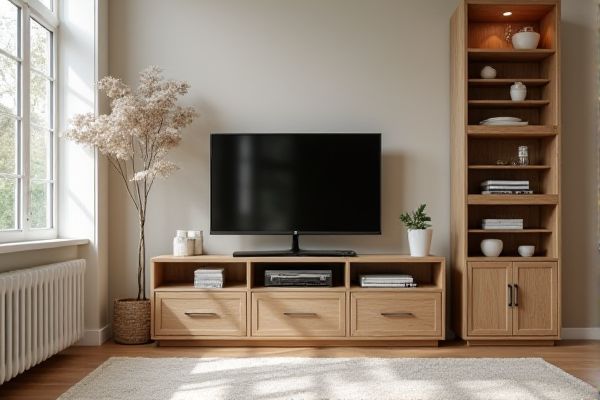
A console cabinet offers a sleek, compact design ideal for smaller spaces and minimalist decor, while a media armoire provides ample storage with doors to conceal electronics and reduce clutter. Discover which option best fits Your entertainment setup by reading the rest of the article.
Table of Comparison
| Feature | Console Cabinet | Media Armoire |
|---|---|---|
| Design | Sleek, low-profile, often open shelves | Tall, enclosed with doors for hidden storage |
| Storage Capacity | Limited storage, mostly surface space | Ample hidden storage for media equipment and accessories |
| Size | Compact, fits small spaces | Larger footprint, requires more space |
| Media Equipment Support | Supports TVs, gaming consoles, and minimal accessories | Designed for extensive media equipment including multiple components |
| Accessibility | Easy access to devices and cables | Doors may limit quick access but reduce clutter |
| Aesthetic | Modern and minimalist look | Traditional or classic furniture style |
| Ideal For | Small rooms, minimalist setups | Large media rooms, organized storage needs |
Introduction to Console Cabinets and Media Armoires
Console cabinets and media armoires serve as stylish storage solutions designed to organize entertainment equipment and media accessories. Console cabinets typically feature a low-profile design with open shelving or cabinets for easy access to devices, making them ideal for compact spaces. Media armoires offer a taller, enclosed structure with doors that conceal televisions and electronics, providing a blend of functionality and aesthetic appeal while saving floor space.
Defining Console Cabinets: Key Features and Styles
Console cabinets are versatile furniture pieces characterized by their narrow depth, open or partially enclosed shelving, and elegant design that fits well in entryways or living rooms. Key features include sleek profiles, a combination of drawers and shelves for storage, and styles ranging from modern minimalist to traditional with ornate detailing. These cabinets prioritize aesthetic appeal while providing practical storage, often complementing TVs or decorative items without overwhelming the space.
What is a Media Armoire? Unique Attributes Explained
A media armoire is a tall, enclosed cabinet designed specifically to house and conceal electronic entertainment components such as televisions, gaming consoles, and media players. Unlike console cabinets, media armoires feature doors that fully close, protecting devices from dust while allowing discreet cable management and ventilation. Your choice of a media armoire ensures a clutter-free living space with organized storage tailored to modern multimedia setups.
Storage Capacity: Console Cabinets vs. Media Armoires
Console cabinets offer limited storage capacity, typically featuring open shelves or small compartments ideal for minimal media accessories. Media armoires provide significantly more storage, including enclosed cabinets, adjustable shelves, and hidden compartments designed to accommodate larger electronics, gaming consoles, DVDs, and additional equipment. Choosing between the two depends on the volume of media components and organizational needs in a living space.
Design and Aesthetic Differences
Console cabinets feature low-profile designs with open shelving or glass-front doors, emphasizing sleek lines and a minimalist aesthetic ideal for modern living rooms. Media armoires offer taller, bulkier structures with enclosed storage, often incorporating ornate details or traditional wood finishes to blend with classic or rustic interiors. The choice between console cabinets and media armoires depends on spatial requirements and desired visual impact, balancing accessibility with decorative style.
Functionality and Versatility Comparison
Console cabinets offer streamlined storage with open shelving and compact drawers, ideal for organizing media devices and accessories in smaller living spaces. Media armoires provide enclosed storage with adjustable shelves and cable management features, accommodating larger audio-visual equipment while maintaining a tidy appearance. The versatility of console cabinets suits minimalist setups, whereas media armoires support more complex entertainment systems with enhanced concealment options.
Space Considerations: Which Fits Your Room Best?
Console cabinets typically offer a low-profile design, making them ideal for small or narrow spaces where vertical storage is limited. Media armoires provide ample vertical storage with doors to conceal equipment, suitable for larger rooms where you can allocate more wall space. Choosing the right option depends on your room's dimensions and your need for hidden storage versus space efficiency.
Maintenance and Durability
Console cabinets typically feature simpler designs with open shelving or minimal doors, making them easier to clean and maintain compared to media armoires, which often have enclosed compartments, doors, and drawers requiring more attention to hinges and hardware. Media armoires are generally sturdier and designed to protect electronic components from dust and damage, offering enhanced durability for sensitive equipment, whereas console cabinets may expose devices to more wear over time. Selecting materials like solid wood or metal can significantly impact the longevity and upkeep requirements for both furniture types.
Price Range and Value for Money
Console cabinets typically range from $150 to $800, offering affordable storage solutions with a minimalist design ideal for smaller spaces. Media armoires, priced between $500 and $2000, provide enhanced versatility with enclosed compartments designed to house televisions and electronics securely. Your choice depends on budget and the value you place on integrated media management versus simple storage.
Choosing the Right Option for Your Entertainment Space
Console cabinets offer a sleek, low-profile design ideal for small spaces, focusing on functionality with open shelves and cable management for media devices. Media armoires provide enclosed storage with doors that hide TVs and equipment, perfect for a clutter-free look and protecting electronics from dust. Selecting between the two depends on your room size, desired aesthetic, and whether you prefer visible display or concealed entertainment systems.
 homyna.com
homyna.com